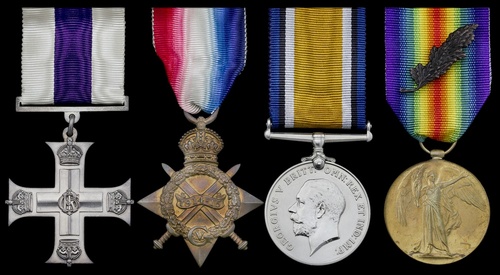
Auction: 19002 - Orders, Decorations and Medals
Lot: 380
A poignant Great War M.C. group of four awarded to Captain B. B. White, Durham Light Infantry, late London Regiment, who was severely wounded by shellfire in the aftermath of the Third Battle of Ypres, having his right leg amputated at the thigh
Military Cross, G.V.R., unnamed in case of issue; 1914-15 Star (730 Pte. B. B. White. 5-Lond. R.); British War and Victory Medal with M.I.D. oakleaf (Capt. B. B. White.), nearly extremely fine (4)
M.C. London Gazette 1 January 1918.
Bernard Burke White was born on 28 August 1887, the son of Alfred M. White of 99 East Sheen Avenue, East Sheen, S.W. London. Educated at Latymer Upper School, Hammersmith, he enlisted on 7 September 1914 as a Private in the 5th (City of London) Battalion, The London Regiment, and embarked from Southampton to France on 27 March 1915, joining the 2/5th Battalion four days later. At that time the majority of the Battalion were still under training at Haywards Heath, Sussex, and it is therefore possible that White served alongside the 1/5th Battalion during the Battle of St. Julien from 24 April-5 May 1915. Transferred to England on 29 August 1915, White received his commission on 8 September 1915, his former Headmaster acting as referee.
On 10 December 1917, whilst serving with the 22nd (Durham Pioneers) Battalion, D.L.I., White was seriously wounded at Passchendaele when struck by pieces of shell. He was evacuated to England nine days later via Dover to begin a long period of recovery. According to the Proceedings of a Medical Board assembled by order of G.O.C. London District, White received three separate injuries:
(1) Glancing scalp wound of right side of head - now healed.
(2) A severe wound of the right knee joint - necessitating amputation through lower 3rd of thigh - stump healed.
(3) A piece of metal entered outer side of left leg - chipped fibula - there is some foot drop due to loss of power & flex on l. ankle. On 19.12.17 there was some haemorrhage from stump and profunda femoris tied.
In a later Medical Board report, it appears that the wounds to his scalp and left leg had largely healed, but he continued to suffer from pain in the sole of the left foot, exacerbated by swelling to the foot and ankle after walking.
It was estimated that as many as 250,000 Allied soldiers lost limbs as a result of new and incredibly destructive weaponry, and the job prospects for men now adjusting to their new identity as a 'cripple' were less than hopeful. As a result, the Government provided help by offering free artificial limbs and The London Illustrated News published regular articles on the prosthetics available to injured members of the armed forces - such as those designed by the Carnes Artificial Limb Company of Kansas City, Missouri. In 1919, White was among those successfully fitted with an artificial limb. It is not known whether he later 'customised' his limb to suit his needs, but he would not have been alone in doing so. Despite the granting of a U.S. patent to James Hanger in 1861 for the 'Hanger Limb,' prosthetics remained in the relative infancy of development in Europe.
White relinquished his Commission on account of being permanently unfit for further service on 12 July 1919, his new address being noted as 49 Edith Road, West Kensington, W.14, London. His Medals were issued on 30 August 1933; sold with copied MIC and officer service papers; M.I.D. as yet unconfirmed.
Subject to 20% VAT on Buyer’s Premium. For more information please view Terms and Conditions for Buyers.
Sold for
£850
Starting price
£700




